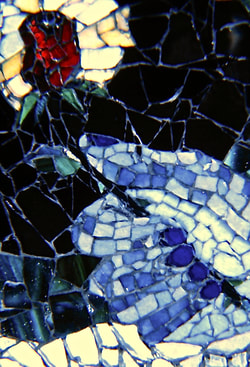Here is a piece, just posted to my website, that I made in 1995 called “A Rebuttal to my Critics (with Aunt Bea Watching)”. It was included in a show at Velvet da Vinci Gallery (1995) and also published on page 32 of the book: The Art of Mosaic Design: a Collection of Contemporary Artists by JoAnn Loctov and Leslie Plummer Clagett. I haven’t wanted to post photos of this piece till now and here is the story of why:
For many years, “A Rebuttal to my Critics (with Aunt Bea Watching)” has been hanging in my living room, featured in a prominent position —- sometimes over the couch. I like this piece well enough, and it was certainly very time consuming to make. (Its diameters are 15.5 inches x 16.75 inches.) I tried to express something that was important to me with this mosaic (well what else is new:) — something that had been sticking in my craw for years!
You see, in the Fall of 1985, I attended graduate school at the San Francisco Art Institute. I was in the MFA program for Printmaking, but I endured only one brief, somewhat tortuous semester and quit that program after my first and last, disastrous, nasty, humiliating, and sad first semester critique. This was the critique where it was just me, the student, proudly displaying my first semester’s efforts with the entire Printmaking faculty there to look, judge, comment, instruct? (no, instruct would be too kind). I won’t go into the gory details here ( I never tire of sharing the story in person, though), but let’s just suffice it to say that I fled my critique in tears, never to return. I did not totally run away, however, as I was employed as a Cataloging Assistant in the San Francisco Art Institute’s Anne Bremer Library and continued to be employed there. That meant that I had to awkwardly rush past my tormentors on an almost daily basis for the next three and a half years! (It was good therapy for this sensitive soul. Hmm…) Back to the story. During this exercise in humility (the critique), one of the negative words that was used by a Faculty member to characterize my work was “trite”. I never forgot that and every time I even hear that adjective, I can feel the slow steep of humiliation and self doubt.
But, like many disappointed and dejected ex-MFA graduate students before me, I survived my ordeal. Some would say I even managed to thrive. Without a press of my own, it was difficult to continue on in printmaking, (people do, though — there are ways to find a press —- I think that I was meant to try something different), so I eventually taught myself how to make mosaics.
Somewhere early in my foray into mosaic-making I began to make three-dimensional hearts. I am not quite sure what prompted me to begin, but I think it was mostly a quasi- unconscious manifestation of my personality. Let me explain. Even in my 30’s I was often clueless about other people’s realities — you mean not everyone senses their world through their emotions, first and foremost? {This was before I had a teenage daughter who liked to subject everyone in her family to the Myers-Briggs Type Indicator personality test where I discovered that I was truly an INFJ (“F” for feeling).} Anyway, making hearts felt kind of natural to me. And then people started to buy them, so onward I went in my heart-making.
I have made so many “hearts” I need to write the word in quotations! They don’t even look like hearts to me! Even so, I have been art-school educated, so there have been times, even knowing that Jim Dine made hearts, was not enough art history knowledge to allay those pesky self-doubts that wondered if the Printmaking faculty was correct in their assessment of me —— maybe their triteness meter had been right on the money?
For many years, “A Rebuttal to my Critics (with Aunt Bea Watching)” has been hanging in my living room, featured in a prominent position —- sometimes over the couch. I like this piece well enough, and it was certainly very time consuming to make. (Its diameters are 15.5 inches x 16.75 inches.) I tried to express something that was important to me with this mosaic (well what else is new:) — something that had been sticking in my craw for years!
You see, in the Fall of 1985, I attended graduate school at the San Francisco Art Institute. I was in the MFA program for Printmaking, but I endured only one brief, somewhat tortuous semester and quit that program after my first and last, disastrous, nasty, humiliating, and sad first semester critique. This was the critique where it was just me, the student, proudly displaying my first semester’s efforts with the entire Printmaking faculty there to look, judge, comment, instruct? (no, instruct would be too kind). I won’t go into the gory details here ( I never tire of sharing the story in person, though), but let’s just suffice it to say that I fled my critique in tears, never to return. I did not totally run away, however, as I was employed as a Cataloging Assistant in the San Francisco Art Institute’s Anne Bremer Library and continued to be employed there. That meant that I had to awkwardly rush past my tormentors on an almost daily basis for the next three and a half years! (It was good therapy for this sensitive soul. Hmm…) Back to the story. During this exercise in humility (the critique), one of the negative words that was used by a Faculty member to characterize my work was “trite”. I never forgot that and every time I even hear that adjective, I can feel the slow steep of humiliation and self doubt.
But, like many disappointed and dejected ex-MFA graduate students before me, I survived my ordeal. Some would say I even managed to thrive. Without a press of my own, it was difficult to continue on in printmaking, (people do, though — there are ways to find a press —- I think that I was meant to try something different), so I eventually taught myself how to make mosaics.
Somewhere early in my foray into mosaic-making I began to make three-dimensional hearts. I am not quite sure what prompted me to begin, but I think it was mostly a quasi- unconscious manifestation of my personality. Let me explain. Even in my 30’s I was often clueless about other people’s realities — you mean not everyone senses their world through their emotions, first and foremost? {This was before I had a teenage daughter who liked to subject everyone in her family to the Myers-Briggs Type Indicator personality test where I discovered that I was truly an INFJ (“F” for feeling).} Anyway, making hearts felt kind of natural to me. And then people started to buy them, so onward I went in my heart-making.
I have made so many “hearts” I need to write the word in quotations! They don’t even look like hearts to me! Even so, I have been art-school educated, so there have been times, even knowing that Jim Dine made hearts, was not enough art history knowledge to allay those pesky self-doubts that wondered if the Printmaking faculty was correct in their assessment of me —— maybe their triteness meter had been right on the money?
At some point, though, I started to think about the word trite. And I started to think about what it meant that I made and used so many heart shapes. Is the use of the heart shape really trite? Why am I attracted to this symbol? How could my feelings be trite? How could anyone’s feelings be trite? Weren’t there things or events or people or questions in this crappy, happy, mixed up world that warranted a strong emotional response? That is the how and why “A Rebuttal for my Critics (With Aunt Bea Watching)” came into being. The text on the bottom curve of the piece reads: “Longing For A World Where A Heart Is Truly Trite”. And I am including above and below, the photos of the text on the rays which emanate from each heart. These are my personal conditions for another world where, okay, I would happily and proudly declare myself the Queen of Trite!
But what about “Aunt Bea Watching” and what about the "Elephant in My Living Room"? Do I really have an elephant hanging out in my front room, nestling with my two cats? or is he restlessly pacing, knocking over the mosaics? Is this why our house is so messy? Nah. More on the "Elephant in My Living Room" later. First, let’s talk about my Aunt Bea.
Aunt Bea was my brother’s godmother and one of my Mom’s closest and oldest friends. I had known her as a kid when I still lived in Connecticut, but even when we moved far away, we kept in touch. When I was about 25, I was fortunate to be able to hang out with her for a bit, and I got to know her and most importantly, to like her. She had not lived a totally care-free life, but there was something about what she had experienced that made her wise and kind; honest and accepting. And she loved and liked me and was excited for me, just starting out, immersing myself in art school. Aunt Bea radiated unconditional acceptance.
We kept in touch, writing notes and letters over the years. She sent gifts for my first born. One day in 1995 while I was with my infant son, waiting for my Mom to come over and give me my weekly respite from full-time Mom duties so that I could do my other work, making mosaic sculptures, and in this case making pieces for an upcoming show, I heard a voice. I thought that maybe it was my Mom, but no, she had not arrived yet; it was just me and my son. And this was a woman’s voice. I had thought I had heard something like “Hi”. It all seemed kind of weird, but I was taking care of a baby so I did not have time to dwell on it. A short time later, my Mom arrived. My Mom was very upset because she had just found out that Aunt Bea had died. We both cried and reminisced. And then I remembered the voice that I had heard. For some reason, I was sure that that had been Aunt Bea’s voice!
That is why Aunt Bea ended up looking on in “A Rebuttal for my Critics (with Aunt Bea Watching)”. I think that her unconditional acceptance and pride in me bolstered my courage, and reminded me about what is important. Even though her name is spelled “Bea” ( it was short for “Albina”), I was playing with the homonym by putting in those two mille-fiore antennae above the eye to symbolize her presence. I think that she would enjoy the pun.
Aunt Bea was my brother’s godmother and one of my Mom’s closest and oldest friends. I had known her as a kid when I still lived in Connecticut, but even when we moved far away, we kept in touch. When I was about 25, I was fortunate to be able to hang out with her for a bit, and I got to know her and most importantly, to like her. She had not lived a totally care-free life, but there was something about what she had experienced that made her wise and kind; honest and accepting. And she loved and liked me and was excited for me, just starting out, immersing myself in art school. Aunt Bea radiated unconditional acceptance.
We kept in touch, writing notes and letters over the years. She sent gifts for my first born. One day in 1995 while I was with my infant son, waiting for my Mom to come over and give me my weekly respite from full-time Mom duties so that I could do my other work, making mosaic sculptures, and in this case making pieces for an upcoming show, I heard a voice. I thought that maybe it was my Mom, but no, she had not arrived yet; it was just me and my son. And this was a woman’s voice. I had thought I had heard something like “Hi”. It all seemed kind of weird, but I was taking care of a baby so I did not have time to dwell on it. A short time later, my Mom arrived. My Mom was very upset because she had just found out that Aunt Bea had died. We both cried and reminisced. And then I remembered the voice that I had heard. For some reason, I was sure that that had been Aunt Bea’s voice!
That is why Aunt Bea ended up looking on in “A Rebuttal for my Critics (with Aunt Bea Watching)”. I think that her unconditional acceptance and pride in me bolstered my courage, and reminded me about what is important. Even though her name is spelled “Bea” ( it was short for “Albina”), I was playing with the homonym by putting in those two mille-fiore antennae above the eye to symbolize her presence. I think that she would enjoy the pun.
Now, let’s talk “ elephant” . Isn’t the shape of “Rebuttal for my Critics….” interesting? When I began work on this piece, I just loved the medallion, shield-like shape. Like all the wood that I use for my sculpture sub-structures, it is either found , recycled, scrap and/or salvaged wood. Often, I found my wood on the street. I no longer have to do this, as I have accumulated quite a stash of scrap wood in my garage! But back in 1995, I was still picking up wood whenever I would happen upon it, during my daily walks. I remember finding that nice shield shape, along with a bunch of scrap, outside a Berkeley home that was being remodeled. That medallion shield shape was an unusual find, and I was so pleased!
Fast forward from 1995, to about the year 2005 (the exact date eludes me). “Rebuttal for my Critics (with Aunt Bea Watching)” has long been made and exhibited and even published. It’s proudly hanging above our couch in our living room. Someone, and I can’t for the life of me remember who, is visiting. They are looking at the beautiful mosaic above our couch and admiring it. And then they say, “Hey, isn’t that in the shape of a toilet seat cover!”. Holy Nellie! I know that they are right.That is SO a toilet seat cover! I had found that very thick plywood that was cut in that medallion shield shape among a curbside pile of scrap outside a home construction site. It was not an actual toilet seat cover — the wood was not finished. Or was it? My heroic medallion shield shape was really a toilet seat shape and all these years, I had not noticed —- the thought had never crossed my mind. Had it crossed everyone else’s mind and were they just too polite to say anything? We had a toilet seat cover hanging over our couch - how utterly embarrassing was that?
I cannot ever look at “Rebuttal for My Critics (with Aunt Bea Watching)” without seeing that mundane ,earthy, inelegant shape. I will never see the medallion shield again. I have to work to keep from inwardly flinching when I think of all those years I unwittingly displayed a toilet seat cover in my living room. And no one, except that one brave soul, ever said anything. Yes, it’s still in my living room. The couch has moved, but the mosaic is now standing guard over my Mom’s china cabinet. I try to keep my focus on the message of the piece and I try to remember, again, about what is important in this life and that Aunt Bea is watching. And laughing.
Dzienkuje and grazie. Thank you very much for reading.
Fast forward from 1995, to about the year 2005 (the exact date eludes me). “Rebuttal for my Critics (with Aunt Bea Watching)” has long been made and exhibited and even published. It’s proudly hanging above our couch in our living room. Someone, and I can’t for the life of me remember who, is visiting. They are looking at the beautiful mosaic above our couch and admiring it. And then they say, “Hey, isn’t that in the shape of a toilet seat cover!”. Holy Nellie! I know that they are right.That is SO a toilet seat cover! I had found that very thick plywood that was cut in that medallion shield shape among a curbside pile of scrap outside a home construction site. It was not an actual toilet seat cover — the wood was not finished. Or was it? My heroic medallion shield shape was really a toilet seat shape and all these years, I had not noticed —- the thought had never crossed my mind. Had it crossed everyone else’s mind and were they just too polite to say anything? We had a toilet seat cover hanging over our couch - how utterly embarrassing was that?
I cannot ever look at “Rebuttal for My Critics (with Aunt Bea Watching)” without seeing that mundane ,earthy, inelegant shape. I will never see the medallion shield again. I have to work to keep from inwardly flinching when I think of all those years I unwittingly displayed a toilet seat cover in my living room. And no one, except that one brave soul, ever said anything. Yes, it’s still in my living room. The couch has moved, but the mosaic is now standing guard over my Mom’s china cabinet. I try to keep my focus on the message of the piece and I try to remember, again, about what is important in this life and that Aunt Bea is watching. And laughing.
Dzienkuje and grazie. Thank you very much for reading.
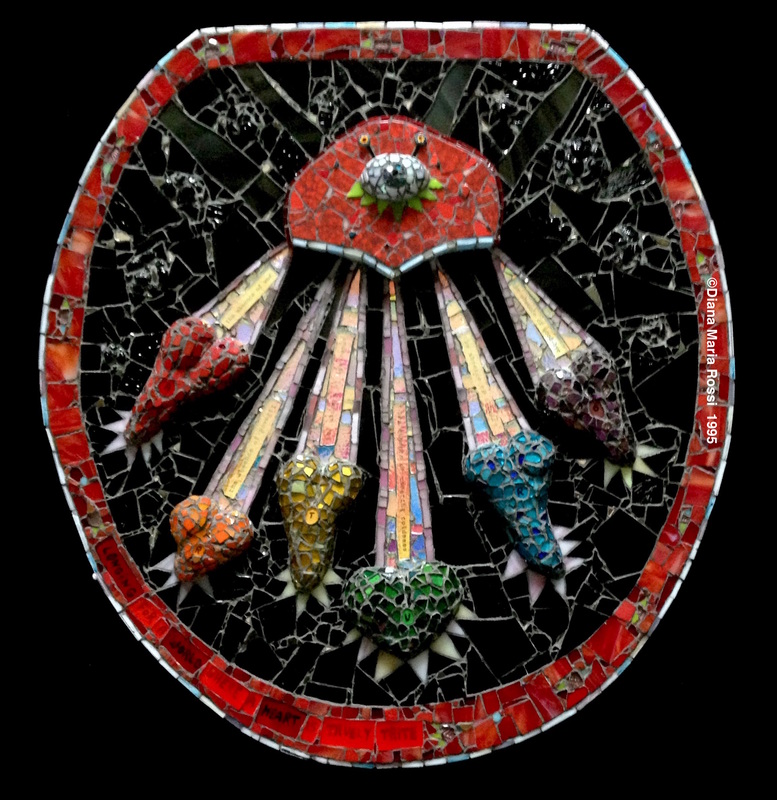
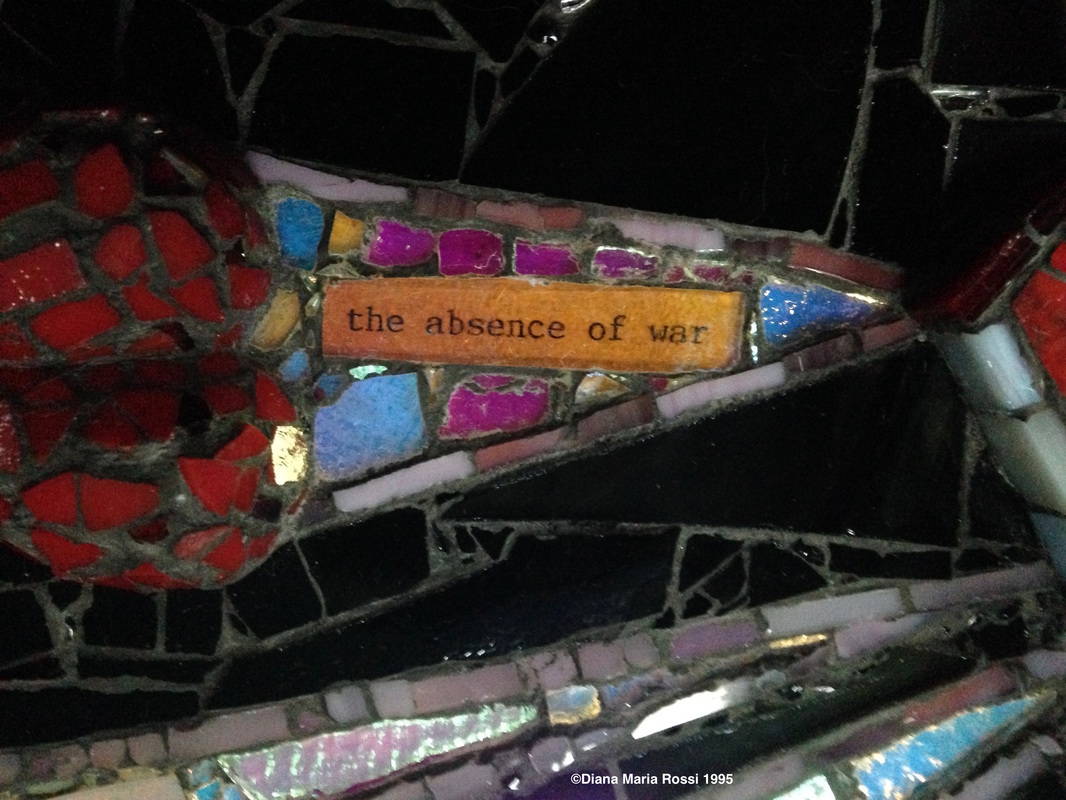
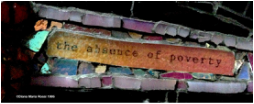
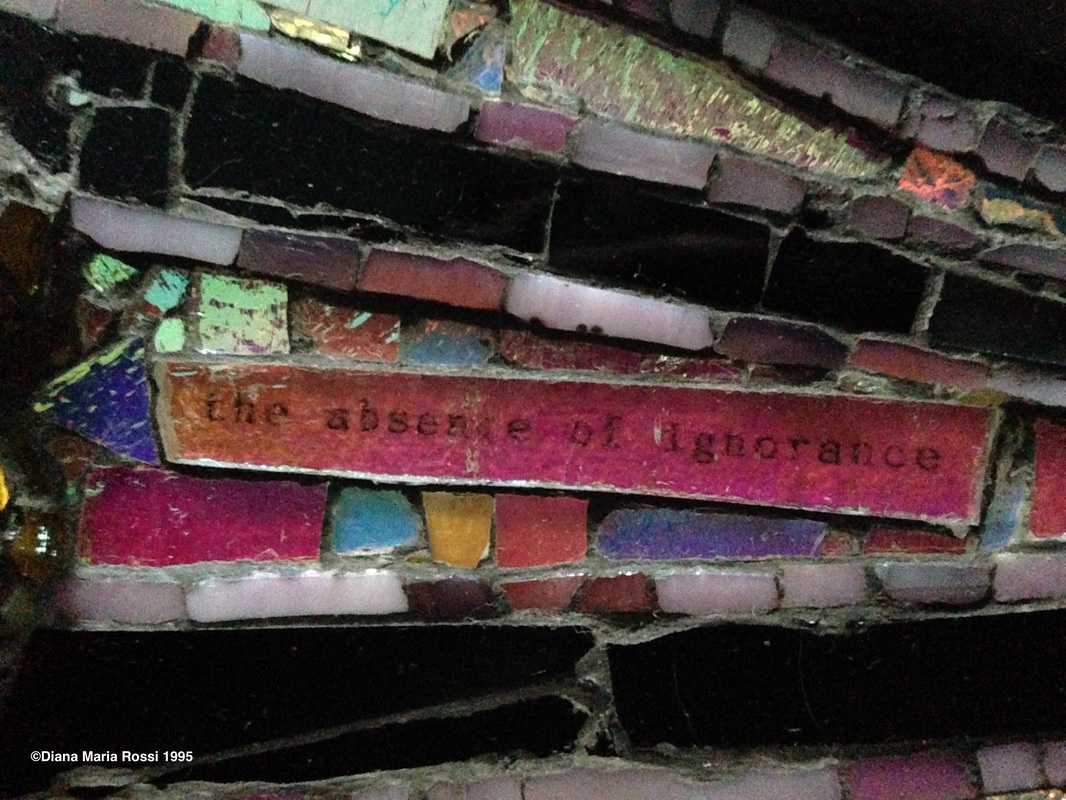
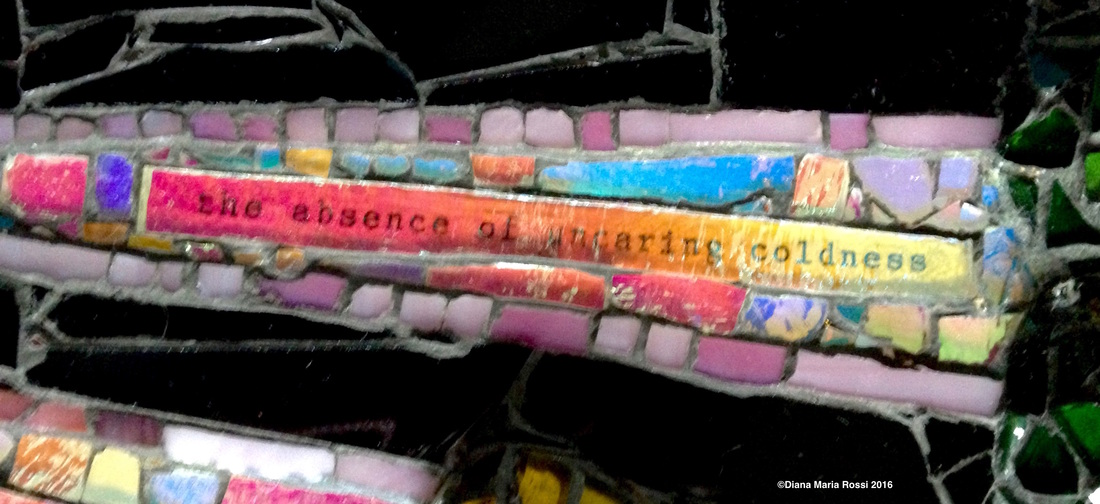
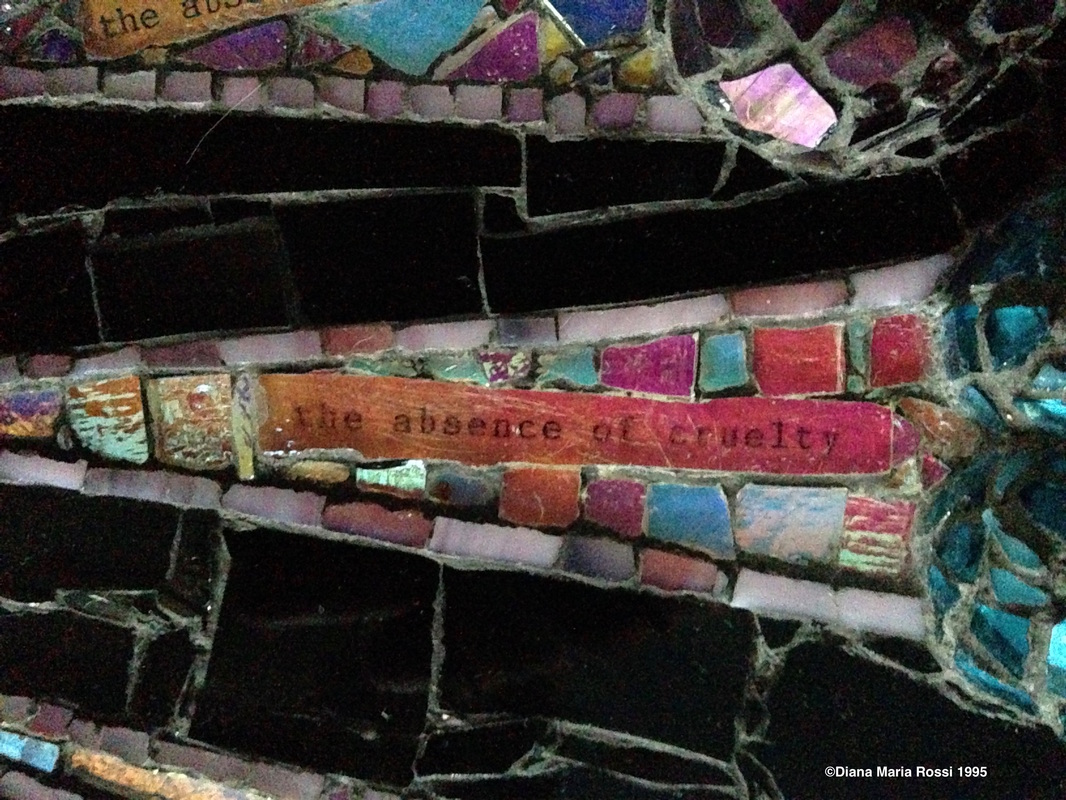
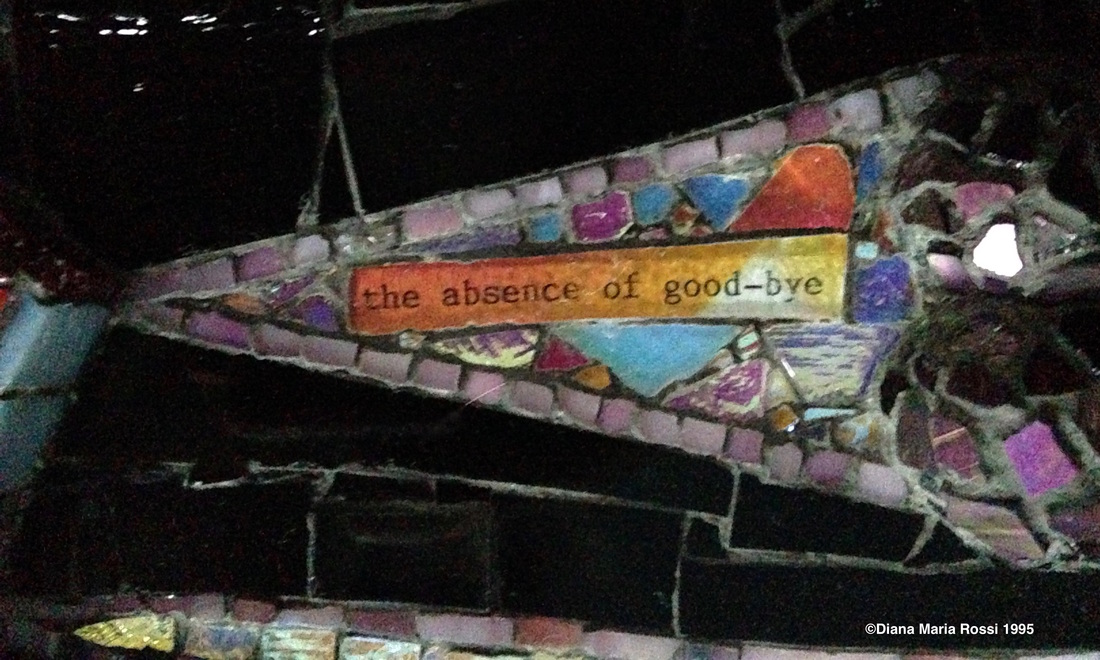
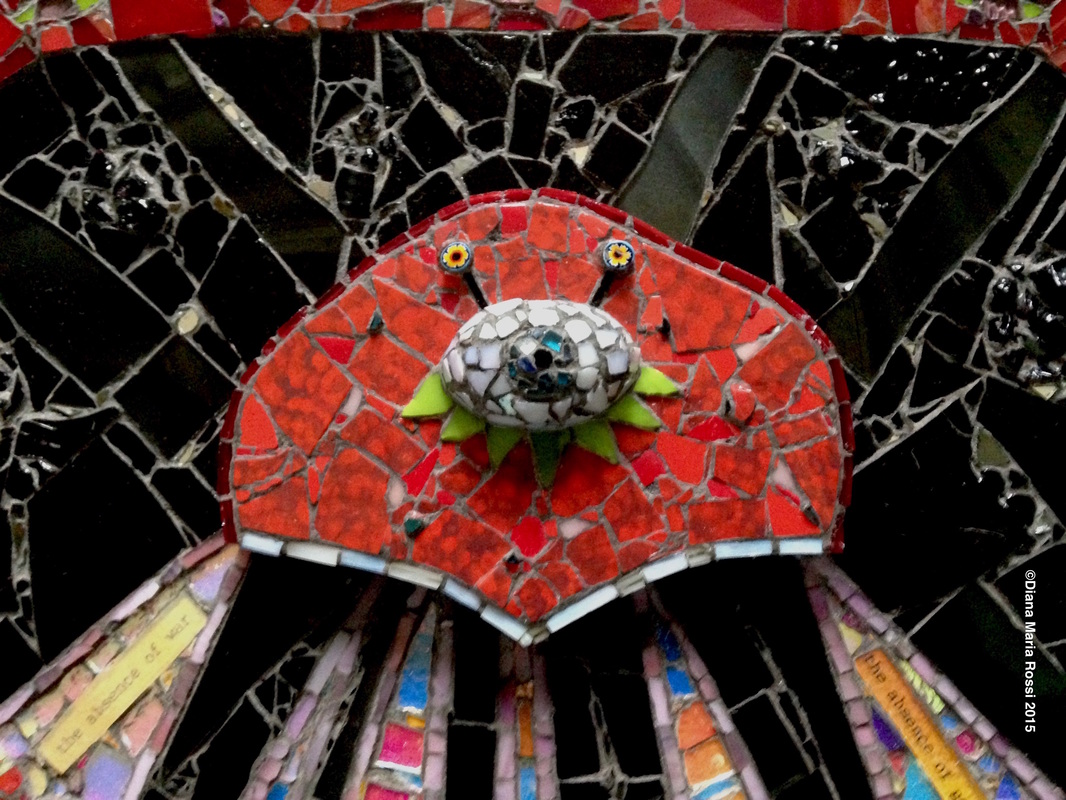
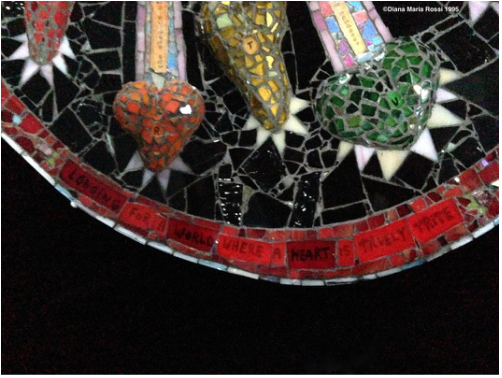
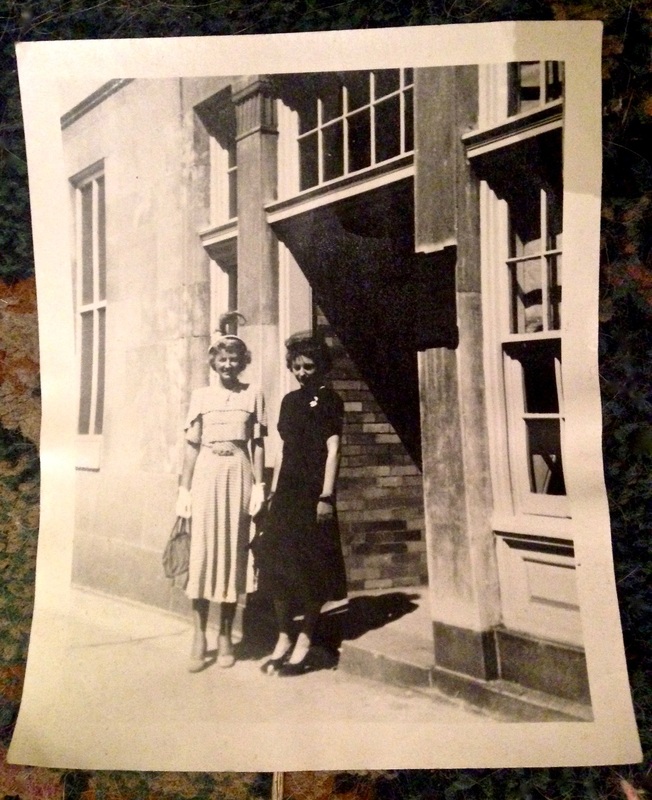
 RSS Feed
RSS Feed
